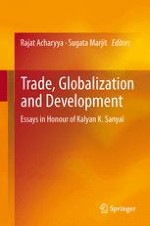2014 | OriginalPaper | Buchkapitel
13. Reforms, Exchange Rate Pass-Through and India’s Export Prices
verfasst von : Saikat Sinha Roy, Pradyut Kumar Pyne
Erschienen in: Trade, Globalization and Development
Verlag: Springer India
Aktivieren Sie unsere intelligente Suche, um passende Fachinhalte oder Patente zu finden.
Wählen Sie Textabschnitte aus um mit Künstlicher Intelligenz passenden Patente zu finden. powered by
Markieren Sie Textabschnitte, um KI-gestützt weitere passende Inhalte zu finden. powered by
